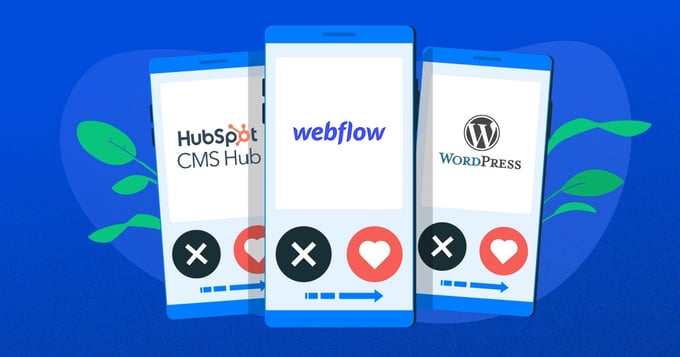What’s the first thing you do when you’re interested in a business or product? Chances are, you start by typing the name into a search engine and visiting the business’s website.
A website is the face of a business, and prospects will make quick judgments based on a site's layout, helpfulness, and usability.
If you want the public face of your business to be one that’s on-brand, organized, engaging, and properly managed, then you’ll want a content management system (CMS) that’s advanced in functionalities, but also intuitive to use.
A CMS allows you to build and manage your website, but not all CMS are created equal! Depending on your priorities, every system offers different features. Three popular CMS are HubSpot, Webflow, and WordPress. These three systems each have their benefits (and a few drawbacks), and once you know what those are, you’ll be better equipped to pick a CMS and build a website that drives results.

Webflow vs. HubSpot vs. WordPress
1. HubSpot CMS
Pros
HubSpot is a great CMS option with an intuitive drag-and-drop website builder and top-notch SEO and blog tools that keep content aligned.
With HubSpot, it’s easy to make and preview changes quickly, and the built-in SSL (the standard website encryption) ensures a secure site with minimal risk of hacking.
Sites on HubSpot’s CMS also tend to have a higher site speed, which positively impacts SEO. The built-in SEO tool ensures that when you’re creating pages and blogs, you’re optimizing the page every step of the way. By the time you’re ready to publish, your pages should be fully optimized for search engines.
Unlike WordPress, HubSpot CMS doesn’t require a ton of plugins to build and operate a site. It has many integrations, so it can work seamlessly with pre-existing software. In fact, HubSpot even has a WordPress integration, which goes to show that different CMS can team up and work together!
One of HubSpot’s most unique features that aren’t common in other CMS is its smart content. With smart content, a website page’s content can adjust based on viewer properties. (For example, a viewer in the Eastern Time Zone would see a webinar landing page catered to EST, while someone viewing the same page across the ocean would see their time.) Smart content lets you cater your site to different segments, allowing you to create a tailored experience and communicate with each user in a way that aligns with their stage of the buyer’s journey.
Cons
HubSpot works best when all its tools are used in harmony (like when segmented email marketing directs to blogs, for example), so the pricing can start getting high if you want to use everything HubSpot has to offer. HubSpot also falls somewhere between WordPress and Webflow when it comes to ease of mastering quickly. The basic version of WordPress is commonly thought of as user-friendly, while Webflow is considered extremely complex. Luckily, HubSpot has an excellent academy with resources dedicated to helping you master every tool.
Also, because WordPress dominates so much of the internet, it’s easier to find WordPress experts and developers than experts in other CMS. Still, HubSpot’s excellent live customer support and painless UX make it worth it for many. (oh, and if you need help with your HubSpot Site, we are here to help!)
2. WordPress
Pros
34% of the internet uses WordPress, and it’s not hard to see why. The basic plan, without any additional plugins, is free, so for those wanting to produce a beginner-friendly website quickly and at a low cost, WordPress works well.
WordPress offers a variety of great plugin options, both free and paid, that allow you to expand on your website easily and add more advanced functionalities. You can use SEO plugins, website builder plugins, and more to create an advanced site that does everything you need it to.
Note: If you’re using WordPress.com (which will actually host your site), these updates will happen automatically, but for WordPress.org (which doesn’t include domain name and hosting), the updates require monitoring.
Cons
The common complaint about WordPress is that sometimes, making a minor change inadvertently causes more changes, and it becomes hard to backtrack. This is especially a problem because WordPress offers a steep learning curve and is not as visually intuitive as other systems, so it’s not easy for the average user to make major changes.
WordPress and its plugins also often have frequent updates, and updates can cause minor glitches on sites until they are ironed out. For example, to keep your site secure, plugins would have to be updated. In that way, WordPress makes it easy to build a site, but a bit harder to manage it, so it’s usually wise to have experienced developers monitor plugin updates.
3. Webflow
Pros
Where Webflow excels is in its web design. Webflow offers a higher degree of customization, and hardcore designers love how powerful the tools are. In tandem with its design prowess, Webflow also offers a wide array of responsive templates, some of which are free.
Unlike the basic version of WordPress, Webflow is a SaaS application that can handle everything for you, including website hosting and security (it includes an SSL, the standard website encryption).
Most reviews consider Webflow an ideal option for designers who don’t want to get involved in the website code.
Cons
The many powerful features of Webflow lead to a steep learning curve, and it is easiest to get the hang of for those with a higher web development skillset. Some users have said that while the design is excellent, the content and blog management needs some improvement and that it can be a struggle to master it all quickly.
Webflow also only offers limited code customization, so if a web developer wants to get into the nitty-gritty of the code to change things, there can be restrictions. Users also dislike the lack of live customer support and the pricing tiers can be high.
Also, unlike HubSpot and WordPress, Webflow is lacking when it comes to SEO. There are limitations to the SEO tool’s capabilities that ultimately might negatively impact SEO or hinder you from reaching SEO goals.
Webflow vs. HubSpot vs. WordPress: The Conclusion
These are just three of the countless CMS out there. Depending on your priorities, you can pick or mix and match the systems. Want a fully customized, design-heavy site? Webflow could work. Looking to get a simple website off the ground in a short span of time? That’s where WordPress could help.
As a HubSpot marketing agency, we’re partial to the HubSpot CMS, which has the perfect mix of standard and unique features and doesn’t take long to master and set up. HubSpot excels in website building AND managing, the perfect combination for driving the right kind of traffic.
Want to Know More?
Looking for a growth marketing agency that can help you get started or transfer over to HubSpot’s CMS? Get in touch today!







